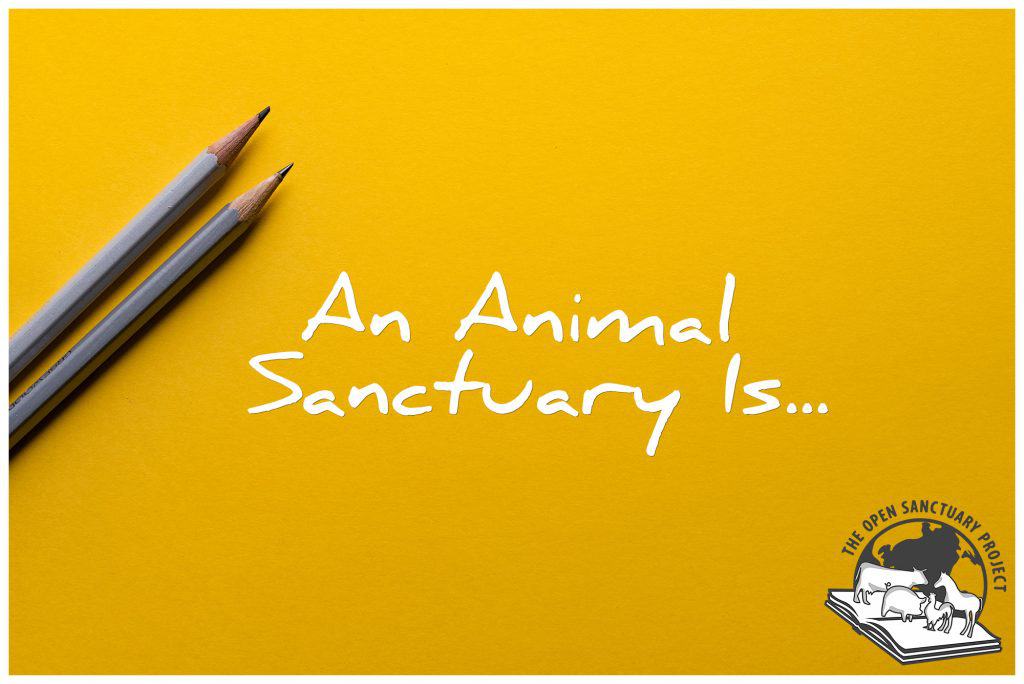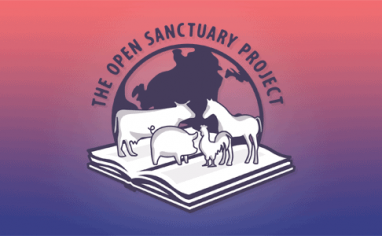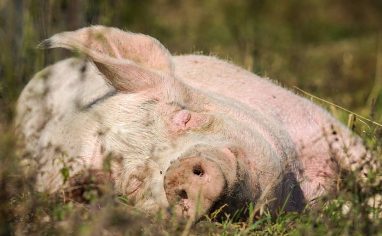
This Is A Legacy Resource!
This resource was originally published early in our organization’s history (December 18, 2018) and has not been thoroughly reviewed in recent years (although minor updates have been made as of May 24, 2024). While we stand by all published resources on our website, we hope to thoroughly review and revise it in the coming year!
Audio Resource: What Defines An Animal Sanctuary? Or A Microsanctuary?
Check out the following audio conversation between The Open Sanctuary Project’s staff and P.E.A.C.E. Canada about this topic!
Speaker 1
The concept of Farm Sanctuary as an organization, not as like a a private somebody does it on their own by their at their house. But the concept of farm Sanctuary as an organization only, it’s really young. It’s only been around since the eighties. I think Farm Sanctuary, New York is one of the first ones in your mind when someone says, Well, there’s only this amount of animals at the place, could they even consider themselves calling them a sanctuary?
What is your thoughts on that? Because I have had personally people come to me and say, oh, they only have like five animals at their sanctuary. Can they even call themselves the sanctuary? I would love your feedback on that. I think, Julia, you.
00;00;43;25 – 00;00;47;15
Speaker 2
Yeah, I think we’re all waiting for Julia to go.
00;00;52;03 – 00;01;31;27
Speaker 1
So I think from, from my lens. Sanctuary is not about numbers per say. It’s about the lens through which you view your residents and the way in which you treat them. So fundamentally to me, it has nothing to do with quantity of animals. And in fact, often times when it comes to quantity and the need to get more and more animals to sort of legitimize or justify yourselves as a nonprofitA non-governmental organization whose primary purpose is something other than selling goods or services. or as a sanctuary can lead to problems with issues like capacity.
And then, in fact, standards can fall maybe, perhaps below what we might consider to be compassionate practices in best practices for the animal sanctuaries. And two of us here have micro sanctuaries. Tara has one and I have one, I don’t think that my micro sanctuary is any less a sanctuary just because I have 20 animals versus, you know, 100.
And in fact, I, I never want to be more than a micro sanctuary, because for me, care standards are the most important, critical thing. And I’m basically at a capacity where I know if I need to at any given point, I can get someone to the vet, I can get them appropriate care, and I’m not going to bust the bank doing it.
And everyone gets the individualized attention that they deserve on a daily basis.
00;02;30;00 – 00;03;07;21
Speaker 2
Just to sort of spin off what what Julia said, I think this, you know, lumping together of, like, sanctuary is always something like a nonprofit or, you know, a really big organization that has staff, volunteers, a bunch of residents, you know, a bunch of different species. It’s just like for me, it’s funny because I do I live with a rooster companion in our house and we were on a call.
Some of the Open Sanctuary Project team members were on a call with Alastor from Micro Sanctuary Resource Center and it was sort of mentioned by someone, I don’t know if it was Julia or elsewhere that like, oh, like Tara has a micro sanctuary. And I was like, but it’s like, do you know? And it was just and I think it’s because I have sort of come up in this having worked in a large sanctuary, I’ve come up with this.
I do, yeah. That I didn’t realize that it’s like sanctuary is this and I never would have been like, Oh, they have five animals. They’re not a sanctuary. But thinking about myself, I was like, Oh, yes, like this. This is a is a thing. So I think it’s just it’s just I feel like it’s a really common notion that I come across in the sanctuary world and one that, like I have perpetuated in a sort of filtered how I even view what I do personally, probably because my first experience with Sanctuary was Farm Sanctuary, which is huge.
And then I worked at Farm Sanctuary and it’s obviously very different. But now caring for someone in a micro sanctuary setting, I will say like, you know, we talk about individualized care and the importance of that. I stand by 100%. But until I cared for cantaloupe as my rooster friend like, until I cared for him in my home, I didn’t really think about the different levels of individualized care.
Right. Like, it’s it’s a spectrum. You can have no individualized care. We’re like animals don’t have names and they don’t. They are looked at as a collective. But I feel like the the degree of individualized care you can provide does change depending on your capacity and who you’re caring for and your relationship with them. So it’s been interesting to see just and sort of reflect on what goes on with cantaloupe in our house and how that would have been in a setting where he was one of, you know, not thousands, not hundreds, but still like one of like a dozen, two dozen, you know, someone who isn’t living right here with me.
And I’m like popping in and out and doing other things and just how that really changes. Like, I know more about him than I know about any other animal I’ve cared for in my caregiving career just because of the, you know, there’s like an intimacy that comes with living with someone. So long story short is it is sanctuary.
And I feel like there are just so many benefits that come with it. So instead of looking at it as like, oh, like you only care for, you know, two animals or five animals, it’s sort of like think about the care that those two or five animals can get, which is really incredible.
00;05;56;01 – 00;06;39;16
Speaker 1
Yeah, I definitely want to tag on to that as well. That Micro Sanctuary is a concept which was, I guess the term was originated by Alastor and Roz, and they founded the Micro Sanctuary Resource Center in order to help people get started in that practice. The other thing is about it is that in an ideal world, right, every animal would have a home and there wouldn’t be distinction between animals who we currently conventionally consider to be companions such as cats and dogs, and say a chicken friend.
For many people who might be interested in sanctuary as a concept in practice, the current model that most people think of, which is the large scale model with hundreds of acres and hundreds of animals, potentially is inaccessible to most people, partly because most people don’t have access to that kind of land. And there may be systemic things at play that also exclude populations of people who have been traditionally disenfranchized from land ownership and stuff like that, where micro sanctuary is a practice is accessible to basically anyone who wants to do it.
And in urban settings you can do it. I know people who have a chicken in their apartment in in the city. I exist in the middle of a city with 20 animals, and it’s possible to do it with this specialized, individualized care. And it creates more homes for the animals and more opportunities for people to practice sanctuary and participate in sanctuary and expands the community in a way I think is incredibly important.
Yeah. And I just want to add here just quickly and then I think, Mackenzie, you wanted to say something, but I just wanted to add with regards to if you do look at taking in an individual at your space, at your home in the city, do check your bylaws. We do get a lot of calls, especially with regards to roosters, because people hatch eggs and they don’t check their bylaws that they’re not roosters or they think they can just find a home and they can’t.
And so that’s just my $0.02 because I think there is some key differences, I think, within the US and Canada, because I think some individuals who need to live on farmland like farm status want to be able to have them like pigs. But I think chickens, if you’re allowed backyard hens in your city, that’s an amazing opportunity for these micro sanctuaries, which I think is such an amazing form of activism and more homes.
Right. Like like you were talking about with regards to sustainability and that one on one personal care that you really like that Tara was talking about that you’re able to give them and we’ll get to know them as a person and their individual quirks and everything like that. So Mckenzee, did you have anything to add?
00;09;08;02 – 00;09;33;23
Speaker 3
Yeah, I think I just wanted to add that it’s important with any collective of an individual and residence or an organization in residence or really anything that involves the care of animals or that reporting care of animals. I think what we always come back to is like you kind of just have to discard the the labels that people use or that even organizations use or what they say in their missionThe stated goals and activities of an organization. An animal sanctuary’s mission is commonly focused on objectives such as animal rescue and public advocacy..
And you just have to look at their practices. And to me, that is what sanctuary is. Is are you minimizing exploitative practices to animals as best you can? And from there, you know, I think you just have to just get really critical and always be striving to do better for your residents. And I think that’s the core of sanctuary, and it’s never been about the numbers.
And, you know, great care can happen. That huge sanctuary is great care can happen in a home environment and the reverse is true as well. So I always just encourage individuals to get curious and look at really organizations and what they’re providing rather than the words that they might use to describe their care.
00;10;21;14 – 00;11;04;13
Speaker 1
I think just one question I have is I think when it comes to micro sanctuary within the sanctuary community, it’s already, as many of us know, there can be strives to fundraising, volunteer sharing. I’m saying could be if there isn’t a good relationship going on and if you’re too close together. But when it comes to micro sanctuaries, I think that what makes the difference between just having them as, quote unquote, petsAnimals who spend regular time with humans in their home and life for companionship or human pleasure. Typically a small subset of animal species are considered to be pets by the general public., as you and Julia mentioned, and being a sanctuary like being able to put on their social media that they’re a sanctuary, is that like a how can we and asking for funds?
I think that’s the thing. If you’re you know, like if you’re a nonprofit organization, you might be fundraising and all those kind of things. But like as a micro sanctuary, when is it just you’re just taking in an individual as a petAn animal who spends regular time with humans in their home and life for companionship or human pleasure. Typically a small subset of animal species are considered to be pets by the general public. rather than promoting yourself as a micro sanctuary, which could, in a sense, lead into more of a nonprofit.
00;11;23;13 – 00;11;54;20
Speaker 2
So this I feel like Julia is going to have thoughts as well that like this came up in that conversation that I was mentioning when we were on a call with Alastor. First of all, I feel like this notion that every sanctuary is a nonprofit, like obviously they shouldn’t be like for profit, but that you’re going to be like a formalized organization and fundraise and all these things like that’s sort of like an that’s not how it has to be.
And that was what I was saying when I was like, Oh yeah. I never really thought of myself as like a micro sanctuary because I don’t have like a name. Like, it’s not like we’re like, you know, Cantaloupe’s Micro Sanctuary or something like that. And I don’t, I think what I exactly what I said was, you know, when we adopted Cantaloupe, we were just adopting him and like welcoming him as a member of our family.
And it wasn’t some thing, right? It wasn’t something where I was going to make like a Facebook page and like post about it and announce it and fundraise and all these things. Like he was just a member of our family and Alastor was like, But that’s it. Like that is like that is micro sanctuary. So I think it’s, it’s getting into this.
I feel like I’ve seen MRC post this thing, this like micro sanctuary is like a state of mind or something like that. Am I making that up? But it’s like I feel like it’s the, the essence of what you’re doing and it’s not that like look at what I am and now I’m fundraising. So I feel like there isn’t a difference.
Like that’s the thing. Like there isn’t a difference. I think what makes it different is that society views certain animals as companion animalsAnimals who spend regular time with humans in their home and life. Typically cats and dogs are considered companion animals, though many species of animals could also be companion animals. traditionally and other animals not. And so when you are doing this like sort of like revolutionary thing of saying that like this animal, that society has decided is food producers, food, whatever is a companion, a family member in my home like that in and of itself to me is like, what makes it like a sanctuary or a sanctuary in general?
In general, right? Like we’re saying that these animals are individuals and worthy of the same care as anybody else.
00;13;40;01 – 00;14;12;25
Speaker 1
I like 100% agree with everything Tara just said and also kind of want to tag on that one of the another distinction that was drawn between your traditional 501c3 model, nonprofit model of sanctuary versus potentially grassroots rescues or grassroots micro sanctuaries is in one sense that the larger scale model is more about profession, and the smaller grassroots model is more about lifestyle.
And I think another point that Alastor raised at one point was, was the question of, you know, if you’re adopting a cat or are you going to do fundraising when you take in that cat? Most people don’t. Right. So why you know, why is it different if you take in a rooster? It’s the fundraising aspect of it.
Part of it, you know, for me, my my group is, again, like Tara’s, it’s completely grassroots. I don’t ask for funding for from anybody. And I, I keep my numbers in my capacity in a way that I don’t need to because it’s just part of my lifestyle to live with these animals as companions. It’s not something that I’ve ever thought about asking for funding for.
It’s just how how we live. So when it comes to I don’t know whether you’re asking, is there is there a line that when you cross that line, a micro sanctuary now becomes a sanctuary? And is that line fundraising? If that’s the question, then I would say that is not the line. I think it’s about care and it’s about compassionate care for your residents regardless of species.
Yeah, I think I was I was more going from one. Can you consider it more like a personal like you both mentioned about? They’re just companions in my house that I self-fund similar to the pet model, it becomes more organizational and as some micro saying, she’s might already look at themselves more organizational and do fundraising and things like that.
So I think it was just figuring out that line between someone coming on as just a companion pet versus being an organizational micro sanctuary.
00;16;13;18 – 00;16;40;01
Speaker 3
I think that has to be just fully personal. It has to just be the decision of how public do you want to, you know, like make your life and do you have aspirations for other missions beyond the care of like a residence or a few residents? And do you want to try to educate people? Do you want to try to like get them to meet your residence?
Or is it strictly something that you’re doing entirely for the resident and but yeah, I think it just depends on the individual and I don’t think there is like a real line to be found. It’s just depends on how you want to organize your life, just like we can all organize our lives in so many different ways. And, you know, it’s if, if you have a spirit like really aspirations to have a macro sanctuary and have the land and you know, obviously we always recommend starting small anyways and volunteering anyways.
But you know, there’s, there’s a infinite ways that you can organize yourself and that you can help animals. And like not even all of those ways include starting a sanctuary or even being involved with direct animal care. You can help make a website for a sanctuary or a sanctuary. We love that you can like just help them run their social media posts and like, or maybe you’re an accountant and like you want to donate some accounting time, that’s all to helping animals.
So I think it’s important to always broaden the scope of what it means to really be a part of really improving animal lives beyond just like I need to stop everything, learn everything I can about helping cowsWhile "cows" can be defined to refer exclusively to female cattle, at The Open Sanctuary Project we refer to domesticated cattle of all ages and sexes as "cows.", helping pigs, helping sheep, helping goats and then get land and then improve the land and then build it. It doesn’t have to be this cascading thing.
It certainly can be. And, you know, there are many successful sanctuaries out there that are doing wonderful things for animals. But I always really encourage people to broaden their perspective of what it can be to to really help the animals and kind of step away from the idea that it has to work this one way.
00;18;22;17 – 00;18;35;08
Speaker 2
One thing I’ll say is, you know, if there are people watching this and are like, really haven’t heard of micro sanctuary before, like really interested Micro Sanctuary Resource Center is the place to go to read all that information about like.
00;18;36;11 – 00;18;46;26
Speaker 1
I agreed that the website’s very useful and they also offer grants and things for individuals starting up, which is great. So do go check that out.
Introduction
If you are a compassionate animal advocate (or aspire to be one), when you think of the phrase “Animal Sanctuary”, many images or fond memories of past visits may come to mind. You might have a general idea of what a sanctuary does and does not advocate for, their visitor experience, or the level of care provided for their residents. However, reality does not always align with our expectations!
In fact, “animal sanctuary” does not carry a strict legal or regulatory definition. This is doubly true for farmed animal sanctuariesAnimal sanctuaries that primarily care for rescued animals that were farmed by humans.. The United States Federal Animal WelfarePractices and policies that promote the well-being of nonhuman animals, specifically their health and comfort. Act doesn’t recognize or suggest unique “farm sanctuary” standards. Thus, farmed animalA species or specific breed of animal that is raised by humans for the use of their bodies or what comes from their bodies. sanctuaries fall under basic USDAThe United States Department of Agriculture, a government department that oversees agriculture and farmed animals. agricultural guidelines in the United States.
Perhaps due to this lack of formal and legal definition, many organizations worldwide have chosen to use “Animal Sanctuary” to describe their mission.
What’s In A Name?
Many organizations with near-identical missions might use completely different words to describe themselves, and many organizations with vastly different missions and philosophies might have almost identical names! When looking at an organization that centers animals, it’s important to carefully review their mission and practices, rather than solely the words they use to label themselves.
So when we at The Open Sanctuary Project talk about animal organizations, how do we define an animal sanctuary? And what kinds of organizational decisions may fall short of our criteria? Here are some guiding philosophies we like to think about:
Location, Quantity of Residents, and Species Mix Do Not Define Sanctuary
Sanctuaries come in all shapes and sizes and can be found in all kinds of places. While you might automatically think of rural spaces and wide open places when it comes to sanctuaries, you can find them in urban centers too! Similarly, when you imagine a sanctuary, you might think of a wide variety of species represented at one location. But in addition to this common model of sanctuary, a sanctuary can be focused on just a single species. You also might imagine a sanctuary to have a large number of residents by default. But a sanctuary can be as small as a single caregiverSomeone who provides daily care, specifically for animal residents at an animal sanctuary, shelter, or rescue. and a single resident, such as in the case of a microsanctuaryA microsanctuary is a small scale community of human and nonhuman (generally “unconventional or farmed”) animal companions, who live together in a chosen shared lifestyle and in commitment to ending the oppression of all beings. Microsanctuaries adhere to the notion that no nonhuman member of the community should “serve a purpose.” Microsanctuaries can exist in any context: rural, suburban, or urban. A microsanctuary can consist of as small a community as one animal and one human caregiver. For more information on microsanctuary please refer to the Microsanctuary Resource Center., where one person lives with a single resident, perhaps even in an apartment.
More On MicrosanctuariesMicrosanctuaries are small scale communities of human and nonhuman (generally “unconventional or farmed”) animal companions, who live together in a chosen shared lifestyle and in commitment to ending the oppression of all beings. Microsanctuaries adhere to the notion that no nonhuman member of the community should “serve a purpose.” Microsanctuaries can exist in any context: rural, suburban, or urban. A microsanctuary can consist of as small a community as one animal and one human caregiver. For more information on microsanctuary please refer to the Microsanctuary Resource Center.!
If you’d like to learn more about microsanctuary, check out the Microsanctuary Resource Center!
You might ask, if you can’t define a sanctuary around size, is there something different about what they do that defines them? The answer is…yes, and no. It’s about both what they say and what they do! It’s about whether the organization maintains a culture, philosophy, and strict policies around compassionate care, AND conducts their day-to-day actions to ensure their residents are not subjected to exploitationExploitation is characterized by the abuse of a position of physical, psychological, emotional, social, or economic vulnerability to obtain agreement from someone (e.g., humans and nonhuman animals) or something (e.g, land and water) that is unable to reasonably refuse an offer or demand. It is also characterized by excessive self gain at the expense of something or someone else’s labor, well-being, and/or existence., bringing us to the next part of our discussion!
Animal Sanctuaries Should Be A Place Of Non-Exploitation
The most important thing an animal sanctuary needs is a culture, philosophy, and strict policies in place to ensure that their residents are not subjected to exploitation and day-to-day practices that reflect these positions. By “non-exploitation”, we mean that residents (or other non-resident members of their species), and anything that comes off of or out of them, are not used either to generate profit or to perpetuate a culture of animal exploitation or harm.
Some specific examples of this exploitation may include:
- Selling or giving away a bird’s eggs for human consumption
- Selling or donating the wool of residents bred for their fiber for human use
- Advocating for or allowing humans to ride residents
- Commodifying resident visits or photo opportunities
- Conflating surrenderThe act of transferring guardianship of an animal to a person or organization, especially via legal contract. or adoption fees as “purchase” or “sales” fees
Where’s The Line?
We understand that it can sometimes be difficult to find public support for animal sanctuaries, and that it may be tempting to generate funding for an animal sanctuary with what may be perceived as “lesser” exploitation. If there’s ever a question of whether an activity is inherently exploitative, a sanctuary should ask themselves, “Who does this action primarily serve?”
If the answer is “humans,” it’s very possibly exploitative to a resident. Even if this action generates income that goes directly back to a sanctuary’s residents, does the perpetuation of a species’ commodification ultimately serve that resident’s species outside of sanctuary grounds?
For more information about how an animal sanctuary can avoid harmThe infliction of mental, emotional, and/or physical pain, suffering, or loss. Harm can occur intentionally or unintentionally and directly or indirectly. Someone can intentionally cause direct harm (e.g., punitively cutting a sheep's skin while shearing them) or unintentionally cause direct harm (e.g., your hand slips while shearing a sheep, causing an accidental wound on their skin). Likewise, someone can intentionally cause indirect harm (e.g., selling socks made from a sanctuary resident's wool and encouraging folks who purchase them to buy more products made from the wool of farmed sheep) or unintentionally cause indirect harm (e.g., selling socks made from a sanctuary resident's wool, which inadvertently perpetuates the idea that it is ok to commodify sheep for their wool). to animals, check out our resource here.
Animal Sanctuaries Should Not Be Motivated By Profit
Animal sanctuaries, whether legally designated as nonprofits or not, should not be profit-driven enterprises. The primary purpose of a sanctuary should always be to provide sanctuary to animals in need. If a sanctuary does sell non-exploitative products or services, the profits should be used for the benefit of the animals and others like them rather than for personal gain.
Animal Sanctuaries Should Put Their Residents’ Needs First
Residents at an animal sanctuary must be prioritized wherever possible and practicable. This philosophy should be one of the guiding principles of how a sanctuary develops, organizes, and operates. Some examples of prioritizing residents at sanctuaries include:
- Committing to the lifelong care of each resident (including providing appropriate veterinary care) or crafting a responsible adoption program
- Providing them with homes that will maximize their health and comfort, protecting them from predators
- Ensuring that residents who share space are not bullied or injured
- Providing appropriate nutrition and enrichment for residents
- Not taking residents out of their home or away from their family for non-medical reasons
- Treating residents as individuals with their own personalities and needs
- Not taking in so many residents that it negatively impacts the care of existing residents
Residents Of Animal Sanctuaries Do Not Serve A Purpose
In a sanctuary, no resident is assigned a “purpose” of any kind and they are not required to serve any larger function. Instead, it is the sanctuary’s primary goal to serve a purpose: providing residents with the best compassionate care available.
Fundamentally, in both philosophy and in practice, a sanctuary’s residents should be considered unique and valuable individuals, whose autonomyThe ability for individuals to have access to free movement, appropriate food, and the ability to reasonably avoid situations they wish to avoid. and comfort are prioritized first and foremost. A sanctuary space is a safe place for them to live out their lives with all of the compassionate care that is required – from vet care, to appropriate food and shelter, to enrichment – to allow them to thrive.
Animal Sanctuaries Should Take In Residents Responsibly
Sanctuaries should prioritize taking in animals who are in immediate need of a safe place to live out their lives, with a well-crafted internal rescue policy to help guide their decision-making process.
Sanctuaries Should Not Breed More Animals
There is an overwhelming need for sanctuary across the world. An animal sanctuary should not breed residents (either intentionally or “accidentally”), or hatch eggs (i.e. breed birds) on sanctuary grounds. Mammalian residents should be spayed (if appropriate and recommended by their veterinarian) or neutered shortly upon arrival to the sanctuary unless it’s too risky to perform the procedure, and additional precautions must be implemented so that these unaltered residents do not have babies. The exception would be taking in residents who are already far along in a pregnancy.
For more information on this topic, check out our resource here.
Animal Sanctuaries Should Have Responsible Visitor Policies
Animal sanctuaries are by no means required to allow visitors on their premises, but should they choose to allow for tours or visits, they must be crafted with the residents’ best interests and agency in mind. A sanctuary should be a resident’s home, where they feel safe, not a place where they’re exhibited to the public for entertainment. All residents should be allowed to ignore and avoid tours or visitors, should they choose to do so. They should not be coerced into interacting with visitors, as a sanctuary is not and should never be a petting zoo. Resident living spaces should be designed with the residents in mind, rather than a potential visitor’s enrichment (though there are certainly ways to give visitors a good experience while prioritizing residents!).
If providing tours, residents should have their personal stories shared when appropriate, and be talked about as individuals rather than strictly as an anonymous collective. There should be an educational component to sanctuary tours, so that visitors have a clear idea of what has necessitated the creation of the sanctuary and how they can help be a part of the solution.
SOURCES:
The Truth About Sanctuaries | Global Federation Of Animal Sanctuaries
What Is A Microsanctuary | The Microsanctuary Resource Center
Why We Need Animal Sanctuaries | Live Science
TRANSLATIONS OF THIS RESOURCE:
Read this resource in Spanish here!
Read this resource in French here!








